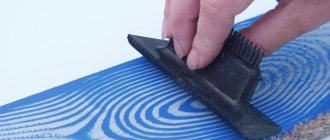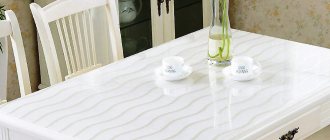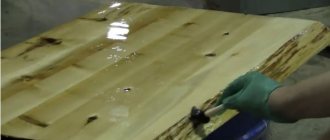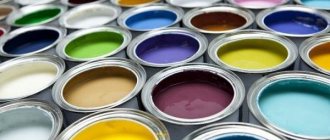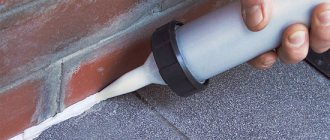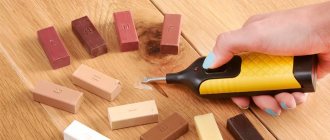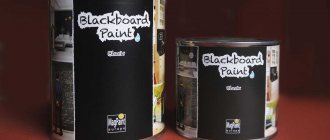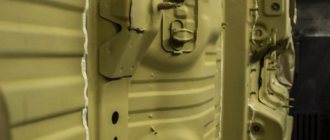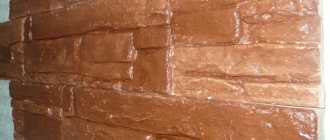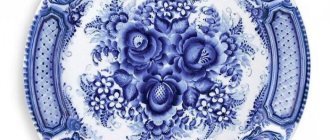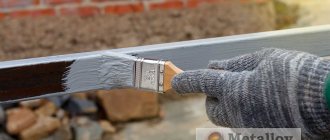The problem probably with all concrete floors is that they generate dust, or rather, sweeping a concrete floor is difficult, since all the sand and all the dust are swept away from it. We were looking for what to do, we searched through a lot of information, tried different floor levelers, also tile adhesive, cement, and so on, but nothing led to the desired result. And then one day I was watching YouTube and accidentally came across liquid glass. Wow, that was something unknown. Essentially, Liquid glass is the same glue (silicate glue). Well, we can say that I found what I was looking for, all that remains is to find where to buy it, since for our town in some stores - Liquid glass is a mystery and something unknown, so I didn’t find it right away. First I took one small 1.4 kg bucket just to see how it would perform
Filled it up. Roughly speaking, 1.4 kg was enough for one and a half square. When it dried, and it took 2-3 days to dry, I liked the result. Closed all the pores. and the floor is not swept.
Well, I took another 10 liters from NSC, but from a different manufacturer
I began to repeat the procedure. I’ll be honest, I didn’t like this Liqui. I didn’t like it because the viscosity is like water, but the manufacturer Ultra has a viscosity like PVA glue. And so we repeat the whole process. spilling it on the floor and rubbing it with a brush. the next day, or rather after a day and a half of drying, it turned into this
On the building materials market today you can find many interesting means for extending the life of buildings, decorating, and creating safe homes. And there are materials that perform all these tasks at once.
These include liquid glass paints, which are actively used in the construction industry and beyond. These are the ones we will talk about. What are these paints? Where can they be used and what are their main features?
What is liquid glass
According to the state standard, liquid glass is a viscous adhesive solution based on sodium silicates, potassium silicates, etc., and water. The material is produced by fusing quartz sand and soda . The second method is autoclave processing of silica-based raw materials and a special concentrated solution; after crushing, it is dissolved in water. The least commonly used method is dissolving silicon in an alkali solution, which most closely corresponds to the classical method. Silicate glue was first produced in 1818 and since then the composition of liquid glass has remained virtually unchanged.
The material is suitable for external and internal work in industrial, individual, and commercial construction.
If we talk about classification, the product is characterized as follows:
- by type of alkaline cation (quaternary ammonium, lithium, sodium, potassium);
- by modular or mass ratio of potassium, sodium, lithium, silicate oxides (essentially, this is the ratio of silicon oxide to sodium oxide multiplied by a special coefficient);
- by the content of impurity oxides;
- by density (g/cm3).
Pouring the flooring
In bathrooms, showers, bath rooms and indoor swimming pools, which are characterized by constant humidity and wet floors, flooring can be made using liquid glass. To fill the floor you need:
- if wooden floors are laid, then first make a concrete screed;
- pour the silicate solution onto the dry surface in equal portions;
- level the glue layer with a wide spatula;
- carry out final leveling of the layer with a thickness of 3-5 mm using a squeegee;
- After the silicate layer has dried, apply a finishing varnish (polyurethane or epoxy is better).
It is worth considering that it is impossible to decorate a floor already covered with liquid glass. When pouring a concrete screed, the floor surface will have a corresponding “concrete” color and texture. Decorating the floor must be done before applying a layer of liquid glass. Alternatively, you can paint the concrete. At the same time, it is recommended to add a small amount of silicate to paints and varnishes to improve their adhesion to concrete. After the paint has dried, you can fill the floor according to the above algorithm.
By the way, taking into account the non-toxicity of the material, its heat and water resistance, it can be used to treat a steam room, which is most often made of wood and can be subject to deformation with constant exposure to moist hot air without proper care.
Types of liquid glass
Depending on the silicates used in the production process, the material is divided into three main types:
- sodium liquid glass - compositions of this type demonstrate excellent adhesiveness and good interaction with mineral bases. This allows for a very strong structure. Finished coatings can be used in various climatic conditions. External negative factors will not affect the waterproofing and anti-corrosion characteristics of the finished layer, created on the basis of sodium silicate glue. The bases receive additional fire resistance;
- potassium liquid glass - this type is also resistant to moisture, acid, precipitation and other atmospheric phenomena. The main difference from the analogue presented above is the absence of glare on the impregnated base. This is appreciated when conducting outdoor work. In addition, this variety is included in silicate paints and painting compounds;
- lithium liquid glass – lithium hardener is characterized by a high solids content. Used for dust removal, compaction, strengthening of new or old concrete bases. The composition is characterized by a high content of active lithium - 11%, therefore it can be applied to concrete of any age, increasing abrasive resistance to 15-40%.
In fact, any option can be used to impregnate concrete. However, sodium silicate glue is cheaper, potassium glue has improved technical characteristics, and lithium glue is the most durable .
When choosing a product, it makes sense to look at the technical specifications. For concrete they work with compounds with a silicate module of 2.8-3.0, density 1.44-1.48 g/cm³.
What are paints on liquid glass?
Liquid glass paints, also known as silicate paints, are aqueous solutions of liquid glass (with sodium or potassium silicates) with colored pigments. There are two types of such paints:
- Actually silicate coatings, also called two-component: they contain, in addition to glass solution, fillers and pigments. These paints contain no organic compounds.
- Dispersion silicate coatings differ from the first group in that, in addition to the main elements, they also contain a synthetic dispersion and a water repellent. The share of organic components here accounts for no more than 5%.
Let’s immediately say that in the production of paints, liquid glass with potassium silicates is most often used, as it provides a more durable and reliable coating.
Note that paints from the first group are usually used to coat mineral substrates. Since they contain, in addition to potassium liquid glass, pigments and fillers that are resistant to alkalis, such coatings are characterized by good vapor permeability.
The second group of paints is easy to use and is used in various fields. Dispersion silicate paints contain special additives that have water-repellent properties. It is this feature that makes them popular in construction work. Coating walls with this paint significantly increases their service life.
Scope of application
In construction, silicate adhesives are used to protect foundations from groundwater, for waterproofing concrete floors, floors, walls, basements, and attics..
The composition works for waterproofing swimming pools - this type of impregnation eliminates the possibility of destruction of the bowl and leaks, plus it provides protection from the negative effects of groundwater.
In this version of waterproofing, liquid glass is applied in 3-4 layers. In any case, protection is provided from the destructive effects of moisture, the base acquires fire-retardant characteristics both indoors and outdoors. In other cases, liquid glass is used to provide waterproofing of wells . The work is being carried out in stages: the first layer is pure silicate glue, the second is silicate glue + cement-sand mixture. Silicate adhesives can be used undiluted or diluted, as part of various additives, impregnations, and mixtures.
Other uses
Liquid glass is also used for many other purposes:
- Silicate glue is widely used as an antiseptic primer for impregnating walls against mold and mildew.
- This material is also useful when laying PVC or linoleum tiles. In this case, the silicate solution will act as glue.
- The high adhesive properties of liquid glass make it possible to use it when sealing or connecting pipes, and caulking joints. In this case, the parts can no longer be disassembled, and if it is necessary to replace one of the elements, the structure will have to be completely dismantled.
- This solution can also be used as an adhesive when repairing furniture made of wood and other materials.
- Gardeners use it to treat trees after pruning. The cut areas become extremely vulnerable to bacteria that spoil the wood. Their putty with liquid glass “seals” the cut and protects the wood from destruction.
Car after protective polishing using liquid glass - This substance can also come to the rescue of housewives: an aqueous solution made in a ratio of 1 to 25 allows you to clean dishes from heavy dirt. To achieve the best effect, it is recommended to boil the dishes in the prepared solution.
- Can be used to remove old paint coatings.
- Silicate solution is even used in agriculture. Experiments have proven that seeds treated with this composition are not susceptible to bacteria and germinate faster.
- Use in wall decoration: when covering walls with glass wallpaper, they are pre-impregnated with liquid glass. This eliminates moisture absorption and increases the wear resistance of glass wallpaper. In some cases, to increase the service life of walls covered with conventional wallpaper and to give them a special shine, a finishing coating is performed with a silicate solution.
- When processing wood products. It is enough to immerse an object made of wood in a container with a silicate solution for some time.
In construction stores, liquid glass is presented in a wide range: both in its pure form and ready-made building materials based on it. Thanks to its low price, this material is available to any consumer, regardless of his income level. The main thing is to choose a composition that is suitable for its characteristics.
Technical characteristics and properties
Impregnation of concrete with liquid glass carries a high functional load. First of all, the material acts as a water repellent - after treatment, the base repels water well. We can talk about antiseptic and antistatic effects, which eliminate the proliferation of bacteria and static electricity on surfaces.
The ability of liquid glass to work as a hardener is interesting - it increases the density of artificial stone by filling the pores. And the last property that I would like to mention is that silicate glue acts as a fire retardant . This indicates protection against acid attack and increased fire-resistant properties.
Table 1. Technical characteristics of liquid glass
| Name | Norm |
| Appearance | Thick liquid of gray or yellowish tint without mechanical inclusions or impurities visible to the naked eye |
| Mass. proportion of silicon dioxide,% | 22.7 – 29.6 |
| The same aluminum oxide,% | 0.25 |
| The same calcium oxide,% | 0.20 |
| The same sulfuric anhydride,% | 0.15 |
| The same sodium oxide,% | 9.3 – 12.8 |
| Density, g/cm3 | 1.36 – 1.45 |
| Mass. proportion of water-insoluble substances, % | 0.2 |
Application for waterproofing
Due to its chemical composition, liquid glass does an excellent job of filling porous materials:
When the surface is treated with a silicate composition, its hydrophobicity and strength increase. Therefore, liquid glass has become particularly widespread in the processing of foundations, walls and floors of basements, wells and swimming pools. To produce a primer with hydrophobic properties, it is necessary to combine water, cement and ironclad in equal proportions.
The surface to be treated must first be prepared: leveled and cleaned of dirt. When processing wood, it is desirable to preserve its natural unevenness (this will ensure better adhesion of materials). If you had to wet the surface during cleaning, then it must be allowed to dry before processing. The thickness of the waterproofing mortar layer must be at least 3 mm.
Silicate solution is also used when covering floors in a bathhouse or bathroom. To create a hydrophilic coating of a large area, for example, to cover a floor or walls, you can use a spray gun, roller or brush.
Application to increase the fire resistance of materials
The fire resistance of liquid glass allows it to be used for:
- masonry of fireplaces, chimneys and stoves;
- production of heat-resistant concrete and cement, as well as fire-resistant paints and varnishes;
- impregnation of wood to give it fire-retardant properties;
- covering elements of metal structures.
To prepare a fireproof silicate mortar, 3 parts sand, 1 part cement and 1 part liquid glass are required. Such a mixture quickly hardens as a result of the chemical reaction that occurs, so you can first make the necessary structure from ordinary mortar, and then apply an external coating of the concrete with a fire-resistant layer.
To give the surface fire-resistant properties, you can coat wood or concrete only with liquid glass from a spray gun, using it as a primer. Walls can also be impregnated either with a separate solution of silicates or in the form of a cement screed for the floor.
Advantages
The first advantage that this type of impregnation brings is the extension of the service life of concrete structures.
In addition, we can talk about a number of other positive characteristics:
- increasing abrasion strength, hardness, and resistance to chemical influences. This is especially true for plinths. The material applied to plastered concrete dampens environmental influences such as shock, friction, snow, rain, dust, temperature changes;
- reduction in water permeability - for example, concrete gables, external walls, concrete platforms often become soaked through after heavy rainfall. Silicate glue will help get rid of this problem;
- we can talk about stable protection against chemistry. The composition protects artificial stone from the action of alkalis, acids, salts;
- strengthening, closing pores - the material works both indoors and outdoors on plain or plastered concrete. Impregnation is used to fill uneven areas, potholes, and pores in the base, which is especially important in places with windy and damp climates;
- the alkaline composition of the impregnation causes an antiseptic effect;
- low consumption against the background of affordable cost;
- work can be carried out in conditions of high humidity.
Flaws:
- quick setting of the solution. Work time is limited;
- the resulting film layer is fragile, which excludes the possibility of using several types of waterproofing.
Brief technology:
For processing, a composition diluted with water in a certain proportion is used.
Use brushes, rollers or a spray gun.
Number of layers 1-2 and above.
Coatings with liquid glass - preparation of solution and basic work
In the construction and renovation of premises, mixtures based on liquid glass are widely used. Despite some difficulties in preparation and work, the antiseptic, hydrophobic, acid-resistant and partly fire-retardant qualities of the surface prevail over the disadvantages. What is liquid glass and what are the principles of working with it?
The basis of the material is sodium silicate or the more expensive potassium silicate. Liquid glass is produced in factories by fusing soda or potash with silicon dioxide. In its pure form, liquid glass is colorless or white crystals.
In construction, an aqueous solution of silicates is used, which is a thick and viscous mixture. Under the influence of carbon dioxide contained in the air, liquid glass hardens, accompanied by the release of amorphous hydrated silicon oxides.
The material is used in the production of acid- and mechanically resistant cements, the production of hydrophobic coatings and paints, as well as the treatment of concrete and wooden surfaces. Methods for preparing mixtures based on liquid glass are characterized by different ratios of added components.
Preparation of silicate solution - tools and consumables
When working with liquid glass, it is best to use ready-made mixtures designed to perform a specific task.
The disadvantage of such mixtures is the high cost and the need to completely use up the entire purchased container. The latter is due to the increased rate of hardening of the mixture after air enters it.
It is much cheaper to use individual components, so manual preparation of solutions is more common, especially since there are a large number of ways to use it.
For a small scope of work in home construction, you will need a set of tools and materials:
- Bucket used only for construction work. The toxicity of silicates is low, but storing food products together with them will not be the best solution.
- A drill with an auger attachment designed for mixing thick solutions.
- Brush or spray (if necessary).
- Cement (ordinary Portland cement is sufficient).
- Fine (sifted) sand.
- Running water or well.
- Putty knife.
- Workwear.
It is necessary to mix liquid glass with water and other components in the proportions recommended for a specific type of work. If surface characteristics lead to reduced adhesion of the mortar, the water content can be reduced or the cement content can be increased.
When diluting liquid glass, cold water is used. To control its quantity and not accidentally add more than required, you should stock up on measuring containers of sufficient volume.
Proportions of components when using liquid glass
Commercially available silicate composition contains a small amount of water, sufficient to maintain a saturated liquid solution. When independently preparing building mixtures, the commercial product and other components are mixed, adjusting the consistency by adding water. For construction and repair purposes, a number of compositions containing cement, sand and other additives are prepared.
Do-it-yourself waterproofing solution preparation technology
When creating a waterproof layer, a mixture of liquid glass and cement or concrete mortar is used in a volume ratio of 1: 10. Working with liquid glass is quite simple.
If cooking instructions indicate proportions of components taken by weight, density values should be used (volume is the ratio of weight to density):
- liquid glass – 1.5 kg/l;
- cement-sand mortar (1: 4) – 2.6-2.7 kg/l;
- concrete solution - 2.2-2.5 kg/l (for the most common heavy concrete);
- quartz sand - 1.5-1.7 kg/l (1.7 for compacted sand, 1.5 for loose sand).
The resulting mixtures are used to fill floors and increase the waterproofing properties of walls. To increase the waterproofness of floors and increase their strength properties, you can fill the outer surface with an additional layer of liquid glass. The thickness of the silicate layer should be about 3 mm and applied in one go - this will ensure maximum strength.
When waterproofing the walls of wells, a solution of liquid glass with cement and fine sand, taken in equal proportions, is used. The resulting mixture is applied to the walls of the well, previously coated with diluted silicate.
If the surface was impregnated with a pure silicate mixture before applying the coating, do not wait for it to completely harden. A monolithic glass-like surface may prevent normal adhesion to the primer or plaster.
Painting works
The color range of silicate paints is low. This is due to their high alkalinity, which leads to the destruction of many pigments. In the production of paints, potassium silicate is usually used - the resulting mixture forms a more stable and uniform structure with coloring pigments.
Silicate paints are sold ready-made or come as separate components that must be mixed before use (liquid glass and pigment). To increase hydrophobicity, small additions of organic polymers (up to 5%) can be added to the composition.
If the surface has previously been painted with an alkyd or acrylic composition, it must be thoroughly cleaned. The best adhesion of silicate paint is obtained with a surface previously treated with lime whitewash or cement composition.
Palette of silicate paints
Exterior works
Waterproof plaster is used to protect wall material from the damaging effects of moisture. The use of hydrophobic plaster in northern regions is of particular importance, since frequent freezing and thawing of water inside the material leads to the appearance of cracks.
For self-preparation of plaster, the optimal proportion of liquid glass, cement and sand is considered to be 1: 2: 5. Before work, as when waterproofing wells, the walls can be pre-coated with diluted silicate.
Padding
In home construction, it is sometimes necessary to prime a concrete screed. The solution used consists of liquid glass and cement in a ratio of 1 to 1. If a layer of tiles is planned to be applied on top of the screed, it is enough to prime with a diluted solution of liquid glass.
The resulting layer impregnates the surface by several millimeters and increases its strength. For laying tiles, you should buy special waterproof cements or use silicate solutions to waterproof the joints.
Surface impregnation
Liquid glass can be applied to concrete or wooden structures with a brush or spray. In the latter case, the silicate mixture is dissolved with water in a ratio of 1 to 5, and its consumption is significantly reduced. Wood is treated with liquid glass to protect against mold and fungi, as well as to increase fire resistance.
The applied silicate layer must be located outside - in this case its protective properties will be maximum. If the wooden elements are small, they can be completely immersed in a solution of liquid glass - this way maximum strength and uniformity of the coating is achieved.
Concrete surfaces and block walls can be coated with an intermediate silicate layer before applying plaster or a layer of tiles. The outer layer of liquid glass protects the surface from mechanical damage, exposure to acids and mold formation in places where moisture accumulates.
Impregnation (coating) of concrete with liquid glass
How to use liquid glass for repair work - filling cracks, crevices and voids
The repair mixture consists of liquid glass, cement and sand in a ratio of 1: 1: 3. The resulting solution is quite thick and does not have time to flow out of wall defects, and the high silicate content leads to rapid setting.
Brief instructions for use and working with liquid glass:
- do not neglect the use of protective equipment - glasses and gloves are necessary. Due to the high alkalinity of silicates, ordinary clothing can quickly become unusable, so it is better to use workwear made of rough tarpaulin or rubberized fabric;
- If necessary, splashes or spills of material can be removed mechanically. Frozen drops of glass are cleaned off with a knife or blade. To facilitate mechanical cleaning, the area can be covered with a wet cloth for several hours.
- Cleaning up large spills of silicate is not an easy task. It is better to work carefully and clean up promptly, not allowing the spilled solution to harden;
- Liquid glass coatings must be renewed every 3-5 years. This will ensure their high strength properties and appearance. Re-coating is easier - similar materials easily “grab” each other.
How does hydrophobic coating using liquid glass work:
Did you like the article? Share with friends on social networks:
And subscribe to site updates in Contact, Odnoklassniki, Facebook, Google Plus or Twitter.
Tools for impregnating concrete with liquid glass
The application of any impregnation requires preliminary preparation of the concrete.
To implement this stage of work you will need the following equipment:
- grinding machines - they work on concrete with powerful and productive devices; you will also need a set of discs with varying degrees of grain size;
- sandblasting, shot blasting machines - for preparation, take durable, powerful machines with a hopper volume of 30-50 liters. Such installations require connection to a compressor, which should also be kept in mind. Productivity should not be lower than 5-10 sq.m./h;
- hard brushes for screed - the tool is used for a limited amount of work, in small areas and in hard-to-reach areas;
- industrial (construction) vacuum cleaners - for effective removal of dust and sludge, a device with high suction power is required - from 250 Bar. In addition, it is convenient to work with machines with a large garbage container - 30-50 liters. You need to make sure that the vacuum cleaner brush fits tightly to the floor;
- construction drill with a mixing attachment - in some cases, special mixtures are prepared based on liquid glass. To prepare them, this particular tool is used, with a power of 1400 W, a speed of 400-700 rpm, and the ability to work in forward and reverse directions.
Advantages and disadvantages of paints based on liquid glass
We have already mentioned above the characteristics of such paints. In this section we will focus on their main advantages and disadvantages.
Among the main advantages of these paints:
- high vapor permeability;
- fire resistance;
- durability;
- low pollution;
- water-repellent properties (especially for dispersion silicate paints);
- complete environmental safety.
But there are several disadvantages to such coatings:
- small range of colors, which is due to the high alkalinity of the paints themselves;
- the diffusion of carbon dioxide is high, which is why it is not recommended to paint concrete surfaces with it;
Technology of impregnation of concrete bases with liquid glass
Work on the installation of concrete foundations is carried out quite quickly - the number of technological operations is small.
Preliminary preparation and general recommendations
The silicate glue itself, in a liquid consistency, is ready for use; you just need to carefully move it with a construction mixer.
Concrete impregnation work is carried out at a temperature not lower than +5 degrees. After collecting the material, the container is kept tightly closed. Other requirements:
- You cannot begin work on treating external surfaces if frost is expected outside in the next 24 hours;
- if the base is covered with frost or ice, the material is not applied;
- If horizontal planes are impregnated, puddles should not be allowed to form.
Any base must be prepared - liquid glass is applied only to clean and dry surfaces.
Principles for preparing concrete foundations:
- the upper loose layers, including iron and cement laitance, are removed. To do this, you can use several methods. On large areas they use sandblasting, shot blasting, and grinding machines;
- hand tools are used at junctions and in hard-to-reach areas;
- the resulting sludge is cleaned out using a construction vacuum cleaner and hard brushes.
Waterproofing liquid glass for floors and flat roofs
Work is carried out after removing the old coating - there should be no sludge or debris on the surface . To do this, clean with a metal brush and use a construction vacuum cleaner. Next, the base is treated with bitumen emulsion, maintaining a layer thickness of 2 mm.
When the composition has set, the solution with liquid glass is poured onto the surface in a layer of 2-3 mm. The coating is leveled with a squeegee or spatula. Before applying the next layer, take a technological break for 2-3 hours. Next, layer 2 is poured.
Impregnation of concrete wells and swimming pools with liquid glass
The waterproofing mixture is prepared on the basis of 1 part silicate glue, 9 parts cement mortar.
Maximum processing efficiency is ensured by following the specified sequence:
- concrete is cleaned of dust and other contaminants with brushes;
- the first layer of impregnation is applied using a roller or brush;
- after 30 minutes, another layer is applied to the surface;
- the material should be distributed as evenly as possible, without gaps;
- Next, you should prepare a solution based on cement and liquid glass;
- the finished mixture is applied to the surface using a spatula. The work is carried out quickly, taking into account the low viability of the solution (15-20 minutes).
Fire resistance of silicate paints
One of the main features of liquid glass-based paints is their fire resistance. Such decorative coatings belong to the class of non-flammable paints.
Their peculiarity is that when dry, these paints form a film that has fire-retardant functions. Paints made from potassium liquid glass are considered to be of the highest quality and resistant to fire.
Typically, non-flammable paints, in addition to glass, also contain special fillers that are highly fire-resistant. It can be ground fluffed or not vermiculite, talc, perlite, kaolin wool fibers, asbestos (fluffed).
Such paints are often supplied in double packaging: a separate mixture of fillers, pigments, additives, etc., and the actual packaging with liquid glass. The paint must be mixed before use. After this, it can only be used for 12 hours.
The characteristics of strength, fire resistance and vapor permeability possessed by paints based on liquid glass have made them indispensable for fire-resistant painting of walls of any premises, creating curtains with fire-retardant properties for cinemas and theaters. These paints will increase the fire safety of any wooden building. In short, when using these paints you will get not only a stylish, but also a safe building.
With the advent of a protective coating based on liquid glass on the construction market, consumers immediately appreciated its unique capabilities. Currently, this composition has a fairly wide scope of use. How is processing done using liquid glass and what is it?
Safety precautions
Liquid glass is not explosive and does not support combustion. The composition is non-toxic. In case of contact with skin or mucous membranes, rinse with copious amounts of warm water.
For ready-made formulations, appropriate storage conditions must be provided . Materials are placed in a cool, dry place. The temperature level can range from +5 to +40 degrees. However, liquid glass is characterized by frost resistance (up to -30 degrees) and can withstand at least 5 thawing/freezing cycles, without losing consumer parameters. Storing near operating equipment or heating elements is prohibited.
Care must be taken to ensure the correct disposal of the product . Its remains are not disposed of on the ground, in sewers, or in water bodies.
Disadvantages of DIY tinting
However, experts assure that this is not worth doing. The tinting of liquid glass does not look so attractive for a number of reasons.
Paints based on liquid glass are not waterproof enough. Liquid glass itself dissolves well in water, and therefore is easily washed out of paints. To obtain paints that are more water-resistant, you need to add chalk, clay or other substances to the glass that increase its resistance to water.
But the addition of such substances reduces the fire-retardant properties of glass-based paint. Because of this, it has to be applied in a thick layer, which significantly complicates and increases the cost of the process.
Substances that react with glass make the paint film porous and easily permeable to moisture. Coating wood with such paint promotes the formation of fungi and mold, shortening its service life.
Silicate glass (especially soda glass) is not resistant to carbon dioxide. And it is always present in the surrounding air. As a result of the chemical reaction of alkali and carbon dioxide, soda is formed, which precipitates in the form of a white coating on the painted surface. Under the influence of the sun, the coating fades and spoils the appearance of the coating.
The film of silicate-based paint is similar to stone and lacks the elasticity that oil paints have. As a result of expansion or contraction of a painted object due to changes in temperature and humidity, cracks quickly form in the film. Over time they increase in volume. This phenomenon is inherent in all silicate paints.
In the industrial production of paints, they try to minimize these unpleasant moments by adding glue or rubber. Starch can also be used. Liquid glass is either potassium glass or a mixture of two varieties.
It is unlikely that you will be able to meet exactly all the conditions when tinting liquid glass yourself. Therefore, experts do not recommend painting surfaces with such paint. No one can guarantee that in a few months the work will not have to be redone. If you really want to try paint based on liquid glass, it is better not to experiment, but to buy it ready-made in a store.
In this article we will tell you the whole truth about protective coatings for cars such as “liquid glass”, you will find out what manufacturers are silent about, what auto centers are silent about (exaggerating, lying, disingenuous) and what to choose in the end. Well, at the end there’s a little advertising, but what would we do without it?
